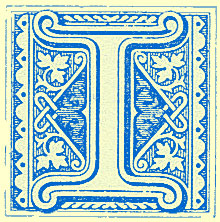[BACK]
[Blueprint] [NEXT]
=============
From Old Church Lore by William Andrews; William Andrews & Co., The Hull Press; London, 1891; pp. 199-202.
 [199]
[199]
Hot Ale at Weddings.
 N the year 1891, a paragraph went the rounds of the north-country newspapers respecting the maintaining of an old wedding custom at Whitburn parish church, near Sunderland. From the days of old to the present time, it has been the practice of sending to the church porch, when a marriage is being solemnised, jugs of spiced ale, locally known as “hot pots.”
N the year 1891, a paragraph went the rounds of the north-country newspapers respecting the maintaining of an old wedding custom at Whitburn parish church, near Sunderland. From the days of old to the present time, it has been the practice of sending to the church porch, when a marriage is being solemnised, jugs of spiced ale, locally known as “hot pots.”
A Whitburn gentleman supplied Mr. Henderson with particulars of his wedding for insertion in “Folk-Lore of the Northern Counties” (London, 1879). “After the vestry scene,” says the correspondent, “the bridal party having formed a procession for leaving the church, we were stopped at the porch by a row of five or six women, ranged to our left hand, each holding a large mug with a cloth over it. These were in
200
turn presented to me, and handed by me to my wife, who, after taking a sip, returned it to me. It was then passed to the next couple, and so on in the same form to all the party. The composition in these mugs was mostly, I am sorry to say, simply horrible; one or two were very fair, one very good. They are sent to the church by all classes, and are considered a great compliment. I have never heard of this custom elsewhere. Here, it has existed beyond the memory of the oldest inhabitant, and an aged fisherwoman, who has been married some sixty-five years, tells me at her wedding there were seventy hot pots.”
Drinking wine and ale at church weddings is by no means a local custom, as suggested by Mr. Henderson’s correspondent. Brand, in his “Popular Antiquities,” and other writers, refer to the subject. On drinking wine in church at marriages, says Brand, “the custom is enjoined in the Hereford Missal. By the Sarum Missal it is directed that the sops immersed in this wine, as well as the liquor itself, and the cup that contained it, should be blessed by the priest. The beverage used on this occasion was to be drunk by the bride and bridegroom and the rest of the company.” It appears that pieces of cake or
201
wafers were immersed in the wine, hence the allusions to sops.
Many of the older poets refer to the practice. In the works of John Heywood, “newlie imprinted 1576,” is a passage as follows:
“The drinke of my brydecup I should have forborne,
Till temperaunce had tempted the taste beforne.
I see now, and shall see, while I am alive,
Who wedth or he be wise shall die or he thrive.”
In the “Compleat Vintner,” 1720, it is asked:
“What priest can join two lovers’ hands,
But wine must seal the marriage bands?
As if celestial wine was thought
Essential to the sacred knot,
And that each bridegroom and his bride
Believ’d they were not firmly ty’d
Till Bacchus, with his bleeding tun,
Had finished what the priest begun.”
Old plays contain allusions to this custom. We read in Dekker’s “Satiro-Mastix”: “And, when we are at church, bring the wine and cakes.” Beaumont and Fletcher, in the “Scornful Lady,” say:
“If my wedding smock were on,
Were the gloves bought and given, the old licence come,
Were the rosemary branches dipt, and all
The hippocras and cakes eat and drunk off.”
At the magnificent marriage of Queen Mary
202
and Philip, in Winchester Cathedral, in 1554, we are told that, “The trumpets sounded, and they both returned, hand in hand, to their traverses in the quire, and there remained until mass was done, at which time wyne and sopes were hallowed, and delivered to them both.”
Numerous other notes similar to the foregoing might be reproduced from old writers, but sufficient have been cited to show how general was the custom in bygone times. The Rev. W. Carr, in his “Glossary of the Craven Dialect,” gives us an illustration of it lingering in another form in the present century. In his definition of Bride-ale, he observes that after the ceremony was concluded at the church, there took place either a foot or horse race, the first to arrive at the dwelling of the bride, “requested to be shown to the chamber of the newly-married pair, then, after he had turned down the bed-clothes, he returns, carrying in his hand a tankard of warm ale, previously prepared, to meet the bride, to whom he triumphantly offers the humble beverage.” The bride, in return for this, presents to him a ribbon as his reward.
=============
[BACK]
[Blueprint] [NEXT]
 N the year 1891, a paragraph went the rounds of the north-country newspapers respecting the maintaining of an old wedding custom at Whitburn parish church, near Sunderland. From the days of old to the present time, it has been the practice of sending to the church porch, when a marriage is being solemnised, jugs of spiced ale, locally known as “hot pots.”
N the year 1891, a paragraph went the rounds of the north-country newspapers respecting the maintaining of an old wedding custom at Whitburn parish church, near Sunderland. From the days of old to the present time, it has been the practice of sending to the church porch, when a marriage is being solemnised, jugs of spiced ale, locally known as “hot pots.”
